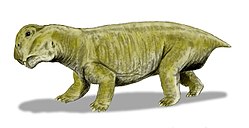| Koupia | |
|---|---|
| Scientific classification | |
| Kingdom: | Animalia |
| Phylum: | Chordata |
| Clade: | Synapsida |
| Clade: | Therapsida |
| Clade: | † Anomodontia |
| Clade: | † Dicynodontia |
| Genus: | † Koupia Boonstra, 1948 |
| Type species | |
| Koupia koupensis Boonstra, 1948 | |
Koupia is a dubious [1] extinct genus of non-mammalian synapsid. The type species, K. koupensis, was coined by Lieuwe Dirk Boonstra in 1948, with a well-preserved skull from the Tapinocephalus Assemblage Zone of South Africa, SAM-PK-11796, designated the holotype. This specimen has since been lost, and K. koupensis is currently considered a nomen dubium [1] or a possible junior synonym of Brachyprosopus broomi . [2]





